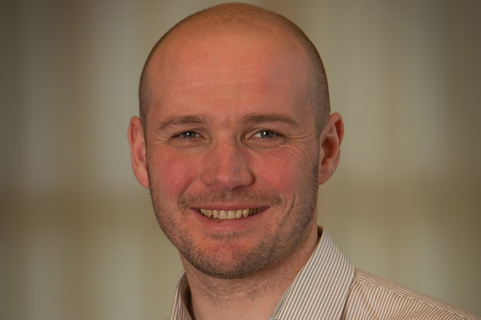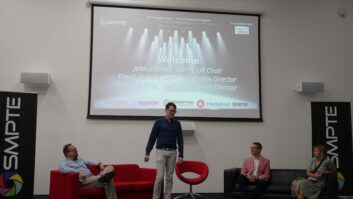
Written by Richard Welsh, SMPTE education vice president-elect and CEO of Sundog Media Toolkit, exclusively for TVBEurope as part of the inaugural ‘year in review’ annual supplement series
The past year has been momentous for the Society of Motion Picture and Television Engineers (SMPTE), which has celebrated its 100th anniversary; a century of leadership in motion-imaging standards and education. Both the Television Academy of Arts and Sciences (ATAS) and the Academy of Motion Picture Arts and Sciences (AMPAS) have recognised SMPTE this year for reaching its century milestone. The AMPAS Special Award plaque honours the fact that, “For one hundred years, the society’s members have nurtured technology, provided essential standards, and offered the expertise, support, tools and infrastructure for the creation and post production of motion pictures.”
Since it was formed by Francis C Jenkins in 1916, SMPTE has developed more than 800 standards, recommended practices, and engineering guidelines that are in force today. All these documents support the society’s primary mission of enabling worldwide interoperability. SMPTE generates an annual average of 50 new standards documents focused on cinema, television, internet video, audio, and associated metadata. For 2016, we are proud to be on track to have produced the most standards ever developed in a single year.
Click here for the full Length Video of the Annual General Membership Meeting
SMPTE’s 2016 standards have advanced time labels: Interoperable Master Format (IMF) — which is becoming essential to both motion picture and broadcast workflows; 6G/12G serial digital interface (SDI) — which supports real-time transport of higher resolution formats; digital cinema; and timing sync (SMPTE ST 2059) — showcased in an interoperability demo at the SMPTE 2016 Annual Technical Conference & Exhibition in October. Other innovations in the works include UHD with HDR, HFR, wider colour gamut (WCG), all of which are raising the bar for imaging and content production.
Through this ongoing standardisation work, SMPTE supplies the industry with the tools to address the current proliferation of media formats, allowing it to move forward in delivering content to the big screen, broadcast and OTT services, as well as to new VR and AR devices. Over the past year, we have seen formats diversify and consumer experience progress. The transition to IP infrastructure continues at pace, requiring new standards for all aspects of delivery — from any camera to any screen. Alongside this, the first SMPTE standard specifically for the unique identification of media files in cloud systems has begun work. SMPTE’s current and future standards must continue addressing new forms of media, new methods of delivery, and new definitions of content consumption as they emerge.
As the media ecosystem continues to evolve, so too do the types of organisations shaping the media and entertainment industry, and SMPTE’s sustaining corporate membership reflects a diverse array of players in today’s marketplace. This year, our diamond members include Amazon, Apple, Blackmagic Design, CBS, Deluxe Technicolor, Disney/ABC/ESPN, Dolby Laboratories, DTS, Ericsson, Fox Entertainment Group, Google, Microsoft, NBC Universal, Netflix, Nokia Technologies, Paramount Pictures, Ross Video, SONY Electronics, Technicolor, Telstra Corporation, Turner and Warner Bros. The society has evolved and adapted to better address the ever broadening range of media technologies while simultaneously strengthening our efforts to increase the membership’s diversity and our global participation.
In the past year, individual SMPTE membership has grown to nearly 7,000 individuals in more than 60 countries, representing almost every continent. The society’s rapid international expansion includes the launch of the Poland section, which was approved by the board of governors in October. Fourteen per cent of our members worldwide are students, and we’re working to build on this growth through a variety of mentoring programmes, scholarships, and educational initiatives. The board also approved three new student chapters: George Mason University in Fairfax, VA; Media Arts Charter High School in Albuquerque, NM; and University of Surrey in the UK in October. Among SMPTE student initiatives are the Louis F Wolf Memorial Scholarship and Student Paper Award. We are also collaborating with our partner, the Hollywood Professional Association (HPA) on projects such as the SMPTE-HPA Student Film Festival and the Young Entertainment Professional (YEP) programme.
SMPTE is uniquely positioned to engage the next generation of media professionals and by helping them understand the art and science that enable rich entertainment experiences. The society educates thousands of individuals each year through webcasts, the virtual classroom, local section meetings and our conferences held around the globe. In 2016 alone, we offered 22 webcasts and have prepared our newest virtual classroom course, on IMF Essentials, for its first session in January 2017.
At NAB Show’s ‘The Future of Cinema Conference: The Immortal Movie’, produced in partnership with SMPTE, crowds were drawn to our conference sessions and special screenings. These events featured top industry minds and creative talents, discussing forward-looking techniques and challenges in creating content for theatrical release and beyond. The highlight of the Future of Cinema Conference was multi-Oscar winning director Ang Lee – known for films including Life of Pi; Crouching Tiger, Hidden Dragon; Brokeback Mountain and Sense and Sensibility – presenting the conference’s 16 April keynote address alongside editor Tim Squyres and production systems supervisor and engineer Ben Gervais. The trio, speaking to a standing-room-only crowd, described their visions of cinema and the creative opportunities within the future of filmmaking. The keynote followed the first public screenings of Lee’s ‘Billy Lynn’s Long Halftime Walk’, for which SMPTE custom built a special screening room. This was able to show the footage in its native 120fps, 4K, 3D format and extra screening sessions were added to accommodate the snaking queues around the Las Vegas Convention Centre.
During the follow-up session titled, ‘Deep Technical Dive into ‘Billy Lynn’s Long Halftime Walk’, Lee, Gervais and Squyres were joined by stereographer Demetri Portelli, Scot Barbour; vice president of production technology for Sony Pictures Entertainment; and David Cohen of Variety, to discuss the technical challenges of production and postproduction in 120fps, 4K, stereoscopic 3D. They explained that continual collaboration between the studio and the technical and creative teams enable using technology efficiently to tell stories in a way that is both emotionally moving and natural for the viewer to watch. ‘Billy Lynn’ was released in November by Sony Pictures and can be viewed only in its native format (often referred to as ‘the whole shebang’) in select theatres including AMC Loews Union Square in New York, Arclight Cinemas Cinerama Dome in Los Angeles, Taiwan’s Vieshow Cinemas in Taipei, the Beijing Bona Youtang International Cineplex and Shanghai Film Art Center.
In July, HPA and SMPTE collaborated to bring the HPA Tech Retreat to the UK for the first time. The Tech Retreat is a pivotal gathering of those supporting the creation, management and dissemination of content for the dynamic landscape of distribution environments. In the UK, we featured two solid days of sessions focused on today’s most relevant topics and timely projects. In addition to the conference sessions, along with a curated Innovation Zone, were organisations demonstrated their latest technologies. For many who had not been able to travel to the US Tech Retreat, this was a unique opportunity for networking, education and technical discovery. We are now working to bring the Tech Retreat back to the UK again this coming July and for summers to come.
The SMPTE 2016 Annual Technical Conference and Exhibition (SMPTE 2016) in October drew nearly 2,500 attendees, a substantial increase from the previous year, for a programme boasting 72 papers, two exhibit halls, 108 exhibitors, and social and networking functions. Filmmaker, innovator, and entrepreneur Douglas Trumbull joined SMPTE president Robert Seidel who is also vice president of engineering and advanced technology at CBS, to present the opening keynote. Alternately addressing cinema and broadcast, the pair took a look at the past, present, and future of media and entertainment technology, as well as supporting standards work. It was a remarkable testament to the progress our industry has made in the years and decades leading to our centennial.
Over the course of SMPTE 2016 week, many of the motion-imaging industry’s creative and technical innovators were honoured with SMPTE honours and awards. At the Centennial Gala, following the conference and exhibition, the society officially awarded honorary membership, the society’s highest honour, to Avatar and Titanic director James Cameron in recognition of his work advancing visual effects (VFX), motion capture, and stereoscopic 3D photography, as well as his experimentation in HFR. The society’s most prestigious medal award, the Progress Medal, was presented to Trumbull, who spearheaded VFX in 2001: A Space Odyssey and Blade Runner. The award recognises Trumbull’s contributions to VFX, stereoscopic 3D, and HFR cinema.
Extending over decades, and continuing to grow, the pioneering work of both Cameron and Trumbull reflects how vital engineering is to the art and science of the motion-imaging field and the progress of the broader media and entertainment industry. As Cameron said in his acceptance speech at the Centennial Gala, “To be here with a group of engineers, and to be acknowledged by engineers, is so much more meaningful to me truthfully, then all the kind of glitz and glamour of the artistic side of Hollywood in a way because at heart, you guys are my peeps. I love engineering.”
[Click here to watch the SMPTE Centennial Gala highlight reel
Like media technologies and creative techniques, SMPTE continues to evolve. In our centennial year, 2016, we can be proud that our commitment to enabling interoperability has remained unchanged.






